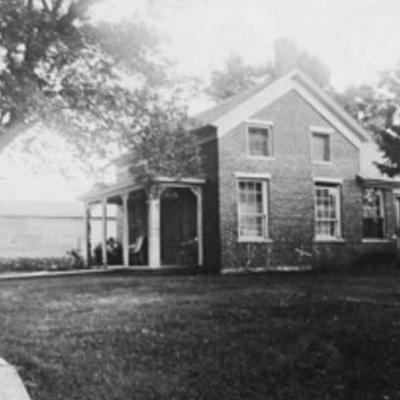In the heart of Waverly, Iowa, along the peaceful banks of the Cedar River, stands a small, sturdy house built by Ira and Asenath Sturdevant.
Its simple architecture, constructed around 1855, reflects the spirit of the first settlers who arrived in the region—a testament to their determination and resilience.
A year prior, Ira Sturdevant and his family had arrived in Bremer County, Iowa, where Ira claimed 40 acres as part of his bounty rights for his service in the War of 1812. Over the next few years, he built a two-story brick house and additions.
This house became not only a home for the Sturdevants but also a haven for Indians, inviting them to rest by the warmth of their fireplace, which still stands today.
It served as a central gathering place for family, witnessing both joy and tragedy, including the Civil War, during which four Sturdevant men served, and only Lafayette returned home.
Despite the hardships, the house stood strong, embodying the spirit of the Sturdevant family. It witnessed Ira’s struggles with illness as he succumbed to tuberculosis and died in the house on April 12, 1862.
Asenath, who followed him in death on May 7, 1867, was buried with Ira in Harlington Cemetery, where generations of their family would eventually reunite.
Over the decades, the Ira and Asenath Sturdevant House became more than just a residence; it became a historical window to the 1850s-1890s. Though many structures from that era have long vanished, the legacy of this house remains—a reminder of the dreams that built Waverly and the commitment of those who laid its foundations including their sons William, Lafayette and other Sturdevant siblings, in those early Waverly years and generations to come, contributing to life in Waverly as we know it today.
Why is preserving the Ira Sturdevant House important?
Preserving the Ira Sturdevant House is important to Waverly because it tells the story of the beginnings of Waverly and can be shared to inspire future generations.
Preservationist Thompson Mays, in his book “Why Old Places Matter,” emphasizes the significance of such landmarks, stating, “It’s a chance to recall who we are, and where we come from old places, holds a power over us long after they were built.”
Wartburg College History Professor Terry Lindell says, “This connection to the past not only enriches our understanding of history but also sheds light on the present. It’s important that we preserve pieces of our past so that we understand from where and when we came. Structures such as the Ira and Asenath Sturdevant House put us in touch with our past in ways no book or essay can do. Understanding the lives of those who have gone before and the buildings they left us helps us understand and appreciate our own lives,” he says.
The Sturdevant House has kept the city of Waverly in contact with its past through many events and activities. Events of the past year include a Heritage Days open house with a calling card activity and a Lovejoy/Sturdevant Watermelon Feed (a summer family tradition), a Historical Family Fall Festival, and even a History Mystery Party to celebrate and explore Waverly’s early history.
Activities included skits and playing historical characters, making food and treats with historical devices such as churning butter, homemade room sprays with flowers from the garden, and making cider using an 1880s fruit press.
Recently, participants made soap, dipped beeswax candles and churned butter for homemade bread. For an upcoming 2025 Heritage Days open house in July, activities such as weaving and broom and rope making are in store.
By preserving the Ira Sturdevant House, Waverly promotes a sense of community and fosters a deeper appreciation for its roots and heritage.
As Preservationist Mays notes, “People matter more than buildings and things, but the spirit of the people - the heartbeat of the community - is in those old things. Many neighborhoods have their own personalities. We feel connected and interconnected, where we live, objects and places remind us of memories, common spaces, are something that we can all share.”
The Ira and Asenath Sturdevant House is in urgent need of restoration. Currently, there is a challenge with a structural bulge in the south original brick wall of the house, threatening the integrity of this historic site.
To address this, the board has engaged Randall Construction, whose experience with working on historic structures will ensure the safety and preservation of the house.
The estimated cost for this vital project is $110,000, which includes shoring up the roof and basement foundation, and dismantling and rebuilding the affected wall.A goal is to restore the original staircase to allow access to the upstairs as part of the museum efforts; however, this cannot happen without rebuilding the wall.
The Sturdevant House board of directors invite you to consider making a donation to support their restoration projects. Every dollar raised will go directly toward the restoration efforts, helping to keep this historical monument standing strong for years to come.
In support of this effort, the Ira Sturdevant House Board just received word that the Max and Helen Guernsey Charitable Foundation has awarded $10,000 to the “Fix the Brick Wall/Buy a Brick!” campaign. In addition to several private donations, the board is hopeful that the community will continue to step up and help save this historic structure.
To donate go to or send tax deductible donations to: ISH, P.O. Box 171, Waverly, IA 50677.
Join the Ira Sturdevant Board, supporters, friends of Ira’s and past donors in honoring the legacy of the Sturdevant Family and preserving Waverly’s history by donating to this 501c3 organization today. Your contribution will ensure that this landmark continues to tell its story for generations to come.











